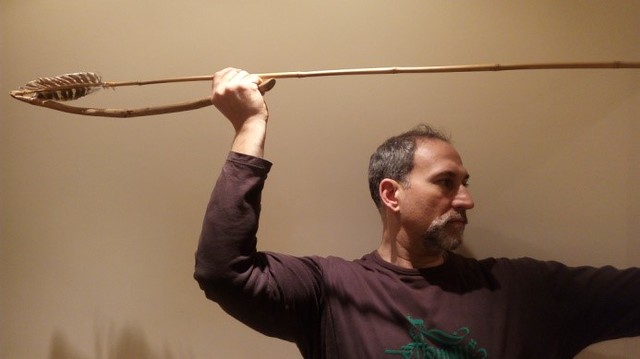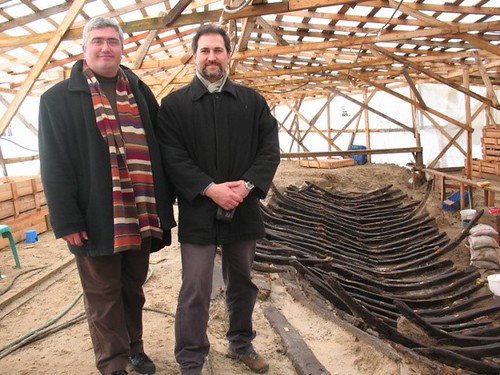 The Ultimate Survival WeaponDr. Murat Özveri It was more than three decades ago when a book about survival by a Turkish author was published and attracted great attention. Among a lot of useful information about building shelter, navigation, finding water and food, there are methods of hunting and trapping too. I remember how I eagerly read about making a self-bow from a fallen dead tree. Many years after I read his book I started archery and somehow it became a lifestyle for me. My interest went beyond shooting a bow. I began to read everything I found, bow making included. Now I know it is not that easy to make a hunting-quality bow, even a simple self-bow, without having specific knowledge and hands-on experience. I am not even mentioning the limited availability of convenient tools in a real survival situation. I have been a pioneer in reviving the Turkish traditional archery and within these 18 years of archery adventure I wrote two books, contributed a few, wrote numerous articles, did researches on museum collections and in sport labs, collected field experience. I was hosted on TV programs and by universities where I shared my know-how with others. I have also tried hard to be a good shooter, tried to acquire practical skill in using a Turkish traditional bow the way it had been used in the past. So I practiced and taught not only “target shooting” which I always believed is a modern approach to archery, but also methods and techniques that make the whole potential of bow reveal as a weapon of war and hunting. I had some experience in bowhunting too, which I consider a part of experimental research, the only legal way to deeply understand how this weapon worked. After all these, I have to admit, I concluded that the traditional bow is not an easy weapon to hunt with, especially in the hands of a non-trained individual who finds themselves in survival situations. Ageing made me a middle-aged man who is seeking more comfort, so “surviving in the nature” became less interesting for me, maybe because I lived my entire life in Istanbul, a metropolitan city where we have completely different “survival” criteria. However my interest in survival weapons did not stay there, in the pages of that old book in the dusty shadows of my youth. I came across another prehistoric weapon at an international archery festival held in South Korea, in 2006. My French friend Bruno Badia-Canes showed me an atlatl he had made and let me shoot. He was so kind that the year after he even sent me an atlatl dart via a common friend. Short after, I made my own replica and started “playing” with it. It was undoubtedly a moment of enlightenment, a great opportunity to understand the development of ancient hunting weapons and step-by-step evolution of human mind and skills. Atlatl or woomera is a spear throwing system that is composed of a long, flexible dart and its thrower. My DIY atlatl thrower and the dart given by Brno Badia-Canes (up) and throwing with the atlatl of my Polish friend Andrej Abratowski in Vsetice, Czechia (down). Atlatl or woomera is a spear throwing system that is composed of a long, flexible dart and its thrower. My DIY atlatl thrower and the dart given by Brno Badia-Canes (left) and throwing with the atlatl of my Polish friend Andrej Abratowski in Vsetice, Czechia (right). Hunting scene on a wall painting in the tomb of Nebemun (British Museum). An interesting opportunity arose short after my very first readings about ancient throwing sticks. Hayri Fehmi Yılmaz, a friend, a renowned art historian and a successful tourist guide, provided me access to the world-famous archaeological site in Yenikapı, Istanbul. The site was well-known with the 36 Byzantine ship wrecks some of which have been preserved extremely well thanks to the anoxic soil of the sea. This area was the lost Harbor of Theodosius and the ships had sunk in a storm as the analysis of geological layers later revealed. Other than a nice tour among these wrecks in situ there was another surprise that not only opened a new gate to learning more about throwing sticks but also changed my life, to say the least. There was another “stratum” or layer underneath of the 1200-year-old Byzantine harbor: a settlement from Neolithic! Hayri Fehmi Yılmaz and I are posing next to a 1200-year-old Byzantine ship wreck, in situ. Yenikapı excavations revealed both the Byzantine Harbor of Theodosius and a Neolithic settlement both providing priceless information. A thick, dark mud preserved this Neolithic settlement that was thought to be 5800 to 6500 years old, with numerous objects of daily life. The site also revealed great information about the burial customs of these very early settlers of Istanbul. Hayri Fehmi Yılmaz mentioned my interest in archery when he introduced me to the archaeologists on field. It was a big chance that one of the archaeologists in charge, Sırrı Çölmekçi, showed me some artifacts which they had had difficulties with in identifying. My heart started beating faster when I first saw three prehistoric wooden weapons which were kept in small water tanks. Wooden artifacts that old are too rare and conservation of such treasures is still a matter of research. The most accepted method is keeping them in salty water as they have been preserved naturally in a similar medium, reducing the concentration of solution gradually and then soaking them into PEG (polyethylenglucol)-solution. PEG is absorbed by the sample and it may take years depending on the size of the given object. A good example of this type of conservation is what done for the wreck of Mary Rose, a familiar archaeological finding for many archery enthusiasts. Not only the numerous longbows found on board but also the ship itself was conserved by following this method. During my visit to England in 2014 to participate in the competition of Society for Promotion of Traditional Archery (SPTA) by the invitation of my good friend Hilary Greenland, I also visited the Mary Rose Museum in Portsmouth. In this museum this method is very well explained by video tutorials revealing the inventions and great efforts of scientists to conserve this Tudor-era ship with all its content. All that very day in Yenikapı I identified these three objects as two throwing sticks and a bow(fragment), a moment that started a long and pleasant journey which opened new intellectual horizons in front of me. One of the two throwing sticks was aerodynamically shaped, so, it was designed to create lift when thrown. “It is an asymmetrical, biconvex hunting boomerang!” were the first words that came out from my mouth when I first saw it. Then it was given to me and I gently held it in my hand. I do remember that I called my wife and said “I just touched an object that is 2000 years older than the oldest temple wall we had touched in Egypt. And it is made of wood!” I was asked for giving lectures to field archaeologists and soon I shared the know-how in the literature of prehistoric bows with them, hunting techniques and trapping methods. It has been the beginning of a nice co-operation with the management and staff of the Istanbul Archaeological Museums. Later, I got an official permission from the minister of Culture of Turkey to work on these subjects, made a replica of this “hunting boomerang” together with many others with different designs. In a few years of reading, making, throwing and experimenting I learned a lot about this amazing prehistoric weapon. Short after I wrote an article revealing the making and testing the very first replica of this weapon of Istanbul’s prehistory. This replica was made of laminated cardboards but worked well, even revealed some remarkable data. And, we even threw it in the archaeological site thousands of years after such a weapon had flown on this land. My archaeologist and conservator friends next to the original of the Yenikapı hunting boomerang and the replica I made. Sırrı Çölmekçi on my right side and Filiz Yalçınkaya Turan next to him. These guys and gals worked so hard, day and night, on this exceptional excavation. World of Archaeology owes many thanks to them (up). Yenikapı hunting boomerang and the very first replica made of cardboard laminations (down). Archery has been in my life since 2002. My main interest is Turkish traditional archery which is really worth working intensively on. It was recently included to UNESCO’s World’s Intangible Cultural Heritage List. However, I find all the archery traditions breathtakingly attractive. Other primitive weapons entered my life thanks to sweet coincidences but undoubtedly helped me understand bow and arrow better. Turkish traditional archery is one of the richest archery traditions in the world. It does not only have a very wide range of shooting techniques but also an amazing art of bowmaking. The Turkish bow has been used as a weapon of war, hunt and sport for almost a thousand year. Turkish flight bow was branded as the ultimate sports tool for flight archers with distance records over 800m achieved by Ottoman archers. Archery left tracks on every aspect of Turkish culture, i.e. art, language, religion and daily life. Slingshot’s access to my arsenal is also related to my work on archery. It was nothing else but a child’s toy for me although I knew that there were some enthusiasts who were efficiently hunting small game with it and releasing videos of their achievements. After an insignificant video of mine I received a call from a young historian PhD who is working on the 12th-13th century weaponry of Turkish Iran, to be more accurate, Seldjukid Empire. He asked me to write an academic article together on pellet bows, or “kemân-ı gerûhe” as it is mentioned in Middle Eastern literature. Pellet bows have been widely used in the world but unluckily very much underestimated by academics, maybe because they appear rarely in military literature, if any. Since I have always emphasized the importance of experimental studies to evaluate the field performances of ancient weapons, the need of a “control” in a possible experiment arose. At that point my attention was pulled by slingshots that replaced these pellet-launching bows in the late 1800’s. In order to evaluate a pellet-bow performance-wise slingshot would be an excellent control-weapon since it had the same purpose, similar principles and – probably – similar kinetic energy levels. A pellet bow I made from my polypropylene kepâze training bow (up) and a Middle Eastern miniature showing a hunter hunting birds with a “kemânkûre”, as pellet-bows are called in Turkish, a term adopted from Persian “kamân-ı gerûhe”. This is the story of how I have had know-how and some experience about primitive and/or simple weapons with which one can stand a chance to survive in wild nature. “To a man with a hammer, everything looks like a nail”, as Mark Twain said. So, it is not rare that I find myself daydreaming in a survival situation, as I used to do in my youth, and contemplate about “the ultimate survival weapon” I would make and efficiently use to feed myself in wild nature. In the next article you will find a detailed comparison of these weapons; what the expected field performances would be, how successful a survivor/hunter would be in making and using them.  |









